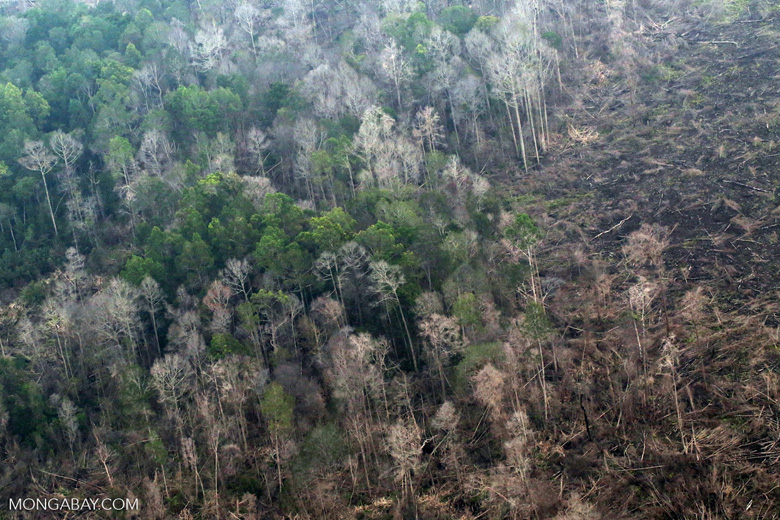- Unless Indonesia takes more drastic measures, it will miss the emission reduction target it has set for itself.
- Current policies are a decent starting point, but they could be strengthened to meet or even surpass the emissions-reduction target.
- The best thing Indonesia can do is strengthen forest licensing moratorium, which has done little to curb deforestation in off-limits areas.
Indonesia, a top carbon polluter, has a plan to cut its emissions.
But unless it takes more drastic measures, it will miss the target it has set for itself, according to a new analysis by the World Resources Institute, a think tank.
Indonesia has pledged to reduce its emissions growth by at least 29 percent over business-as-usual levels by 2030. That means it can emit no more than 2 gigatons of carbon dioxide that year.
But even if it follows through on existing policies aimed at reducing emissions, Indonesia will emit 2.3 gigatons of carbon in 2030, just a 19 percent drop, according to the WRI.
Indonesia produced an estimated 1.8 gigatons in 2005, and 1.4 gigatons in 2000.
“We need mitigation actions that are more ambitious than the current ones,” Arief Wijaya, climate and forests senior manager at WRI Indonesia, told reporters in Jakarta.
Indonesia’s prolific output of greenhouse gases is due less to the burning of fossil fuels than to the conversion of its rainforests and peatlands for agriculture. At the same time, coal consumption is rapidly increasing in the archipelago country.
Together, the land-use and energy sectors account for four-fifths of Indonesia’s emissions.
To cut emissions, Indonesia has declared a moratorium on new licenses to clear “primary” forests and peat swamps; made plans to restore some 2 million hectares of degraded peat swamps; and taken other measures to conserve these carbon-rich environments. It has also set various renewable-energy goals.
While these policies are a decent starting point, they could be strengthened to meet or even surpass the 2030 target, the WRI found.
Options include strengthening the licensing moratorium, restoring an additional 4.6 million hectares of degraded forest and peat, and implementing energy conservation policies. Doing all of this would reduce total emissions to 1.7 gigatons of carbon dioxide, surpassing Indonesia’s current commitment.
The best thing Indonesia can do is strengthen the moratorium, which has done little to curb deforestation in off-limits areas, said Hanny Chrysolite, forest and climate program officer for WRI Indonesia.
In 2015, forest loss in moratorium areas continued to increase in all regions except Sumatra, suggesting that the policy has done little to protect forests, according to 2015 tree cover loss data from the Global Land Analysis & Discovery (GLAD) lab at the University of Maryland.
Critics of the moratorium say it is poorly enforced and that it should also cover all forests, not just primary forests. A primary forest is an ancient forest, as opposed to a “secondary” regenerating one.
Improving enforcement and renewing the moratorium through 2030 “could reduce emissions by 188 million tons of CO2,” Chrysolite said.
Expanding the moratorium to include both secondary forest and forested areas already licensed out to developers could further reduce emissions by 427 million tons of CO2 in 2030.

While the moratorium has the largest mitigation potential, Wijaya said the government should not neglect the energy sector, which is on pace to overtake the land-use sector as Indonesia’s biggest greenhouse gas emitter.
He said the energy sector would contribute 50 percent of emissions in 2030, up from 28 percent in 2010, as demand for energy increases.
“Indonesia is very focused on climate change mitigation in the land-use sector,” Wijaya said. “But this study shows that the government should be wiser. They shouldn’t just focus on the land-use sector, but also the energy sector as it would overtake the land-use sector in less than 15 years from now.”
Therefore, Wijaya said, the government should strengthen its energy policies by promoting energy conservation.
“We know that demand for energy keeps growing. So it will be very important that we have an energy policy that is more efficient. Maybe we need carbon tax policies or vehicles that are more fuel efficient,” he said.
Nur Masripatin, climate change director-general at the Ministry of Environment and Forestry, who leads Indonesia’s efforts in climate change, declined to comment, saying she would first have to study the WRI report.
Banner image: A burned peat swamp on Indonesia’s main western island of Sumatra. Tropical rainforests rarely burned in the past, but are seeing serious wildfires as climate change worsens. Photo by Rhett A. Butler/Mongabay.
